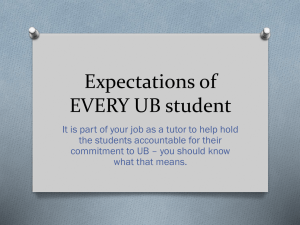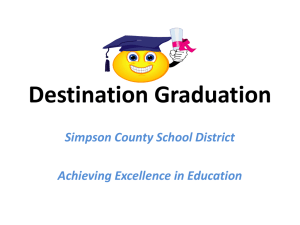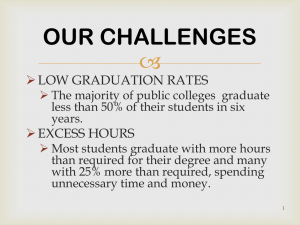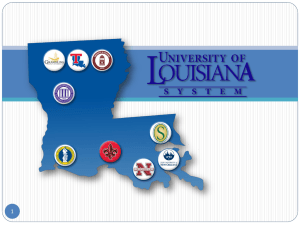Annotated Bibliography of Research on Raising Graduation
advertisement
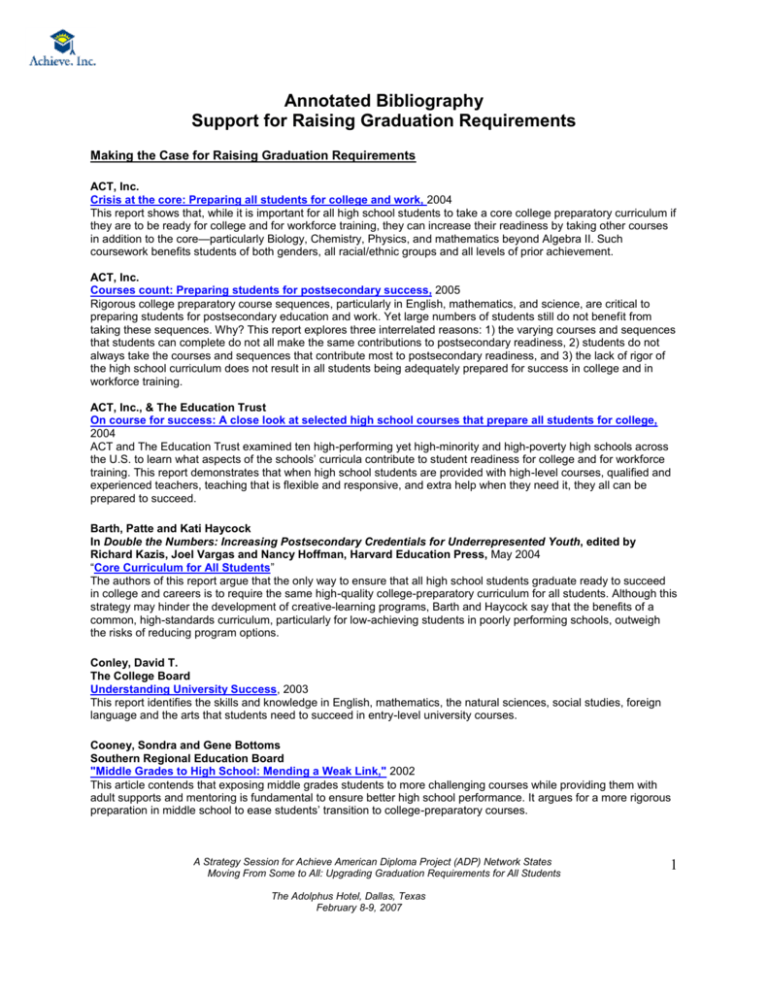
Annotated Bibliography Support for Raising Graduation Requirements Making the Case for Raising Graduation Requirements ACT, Inc. Crisis at the core: Preparing all students for college and work, 2004 This report shows that, while it is important for all high school students to take a core college preparatory curriculum if they are to be ready for college and for workforce training, they can increase their readiness by taking other courses in addition to the core—particularly Biology, Chemistry, Physics, and mathematics beyond Algebra II. Such coursework benefits students of both genders, all racial/ethnic groups and all levels of prior achievement. ACT, Inc. Courses count: Preparing students for postsecondary success, 2005 Rigorous college preparatory course sequences, particularly in English, mathematics, and science, are critical to preparing students for postsecondary education and work. Yet large numbers of students still do not benefit from taking these sequences. Why? This report explores three interrelated reasons: 1) the varying courses and sequences that students can complete do not all make the same contributions to postsecondary readiness, 2) students do not always take the courses and sequences that contribute most to postsecondary readiness, and 3) the lack of rigor of the high school curriculum does not result in all students being adequately prepared for success in college and in workforce training. ACT, Inc., & The Education Trust On course for success: A close look at selected high school courses that prepare all students for college, 2004 ACT and The Education Trust examined ten high-performing yet high-minority and high-poverty high schools across the U.S. to learn what aspects of the schools’ curricula contribute to student readiness for college and for workforce training. This report demonstrates that when high school students are provided with high-level courses, qualified and experienced teachers, teaching that is flexible and responsive, and extra help when they need it, they all can be prepared to succeed. Barth, Patte and Kati Haycock In Double the Numbers: Increasing Postsecondary Credentials for Underrepresented Youth, edited by Richard Kazis, Joel Vargas and Nancy Hoffman, Harvard Education Press, May 2004 “Core Curriculum for All Students” The authors of this report argue that the only way to ensure that all high school students graduate ready to succeed in college and careers is to require the same high-quality college-preparatory curriculum for all students. Although this strategy may hinder the development of creative-learning programs, Barth and Haycock say that the benefits of a common, high-standards curriculum, particularly for low-achieving students in poorly performing schools, outweigh the risks of reducing program options. Conley, David T. The College Board Understanding University Success, 2003 This report identifies the skills and knowledge in English, mathematics, the natural sciences, social studies, foreign language and the arts that students need to succeed in entry-level university courses. Cooney, Sondra and Gene Bottoms Southern Regional Education Board "Middle Grades to High School: Mending a Weak Link," 2002 This article contends that exposing middle grades students to more challenging courses while providing them with adult supports and mentoring is fundamental to ensure better high school performance. It argues for a more rigorous preparation in middle school to ease students’ transition to college-preparatory courses. A Strategy Session for Achieve American Diploma Project (ADP) Network States Moving From Some to All: Upgrading Graduation Requirements for All Students The Adolphus Hotel, Dallas, Texas February 8-9, 2007 1 The Education Trust A new core curriculum for all: Aiming high for other people’s children. Thinking K–16, 7(1), 2003, Winter This special issue of the Education Trust’s publication Thinking K–16 focuses on the need for all high school students to complete a rigorous core curriculum regardless of whether they plan to attend college immediately after graduation or enter directly into the workforce. In addition, the material in the issue provides support for the contention that all students, not just the highest-achieving, are capable of doing the work required by such a curriculum. Horn, L. and L.K. Kojaku U.S. Department of Education, National Center for Education Statistics High School Academic Curriculum and the Persistence Path through College: Persistence and Transfer Behavior of Undergraduates 3 Years After Entering 4-year Institutions, 2001 This report found the numbers of students taking rigorous high school courses positively affects college persistence for all students. It examines socioeconomics, types of college and freshman grade point average as part of the methodology. National Governors Association Getting it done: Ten steps to a state action agenda. (Redesigning the American High School), 2005 As part of his 2005 initiative as chairman of the National Governors Association (NGA), Virginia Governor Mark Warner, working with the NGA Center for Best Practices, identified ten steps governors can take to put their states on the right path toward redesigning high schools. These recommendations include creating a permanent education roundtable or commission and defining a rigorous college and work preparatory curriculum for high school graduation. Rosenbaum, James E. American Federation of Teachers Time to Tell the Kids: If You Don't Do Well in High School, You Won’t Do Well in College (or on the Job), 2004 This report examines open-enrollment admissions and the large numbers of students who enter college but do not graduate. It discusses steps needed to increase the odds of college graduation and ways to help students find productive, successful post-high school paths. Schoeff, Mark Jr. only include if you have a hyperlink – otherwise delete Workforce Management, March 13, 2006, pp. 46–49 Amid calls to bolster U.S. innovation, experts lament paucity of basic math skills. Warburton, E.C., R. Bugarin and A.M. Nuñez U.S. Department of Education, National Center for Education Statistics Bridging the Gap: Academic Preparation and Postsecondary Success of First-Generation Students, 2001 This report examines the high school preparation and postsecondary persistence of first-generation college students (students whose parents had no education beyond high school) and compares them with students whose parents went to college. It found that rigorous preparation in high school substantially narrows the gap in postsecondary outcomes between first-generation students and their peers whose parents graduated from college. A Strategy Session for Achieve American Diploma Project (ADP) Network States Moving From Some to All: Upgrading Graduation Requirements for All Students The Adolphus Hotel, Dallas, Texas February 8-9, 2007 2 Making the Case that All Students Need Challenging Math in High School Adelman, Clifford U.S. Department of Education The Toolbox Revisited: Paths to Degree Completion from High School through College, 2006 This study follows a nationally representative cohort of students from high school through college to show major predictors for the completion of a bachelor’s degree. It found that significant factors include: high school curricula, postsecondary benchmarks, students’ time management, college migration and students’ academic performance. Adelman found that the highest level of math taken in high school has the most powerful relationship to earning a bachelor’s degree. This is true regardless of student ethnicity, family income or parents’ education levels. Students who complete Algebra II in high school more than double their chances of earning a four-year college degree. Carey, Kevin Education Sector “High Schools Failing to Prepare Many College-Bound Students for Science Careers” This article recommends raising the bar on high school math courses to increase the number of students graduating from the fields of science, technology, engineering and mathematics in college and thereby preparing more students for science careers. Gamoran, Adam and Eileen C. Hannigan JSTOR: The Scholarly Journal Archive Educational Evaluation and Policy Analysis, Autumn 2000, Vol. 22, No. 3, pp. 241–254 “Algebra for Everyone? Benefits of College-Preparatory Mathematics for Students with Diverse Abilities in Early Secondary School” This report presents new evidence of the benefits of college-preparatory mathematics, particularly algebra, for students with disparate level of competencies. Algebra is beneficial for all students, although its benefits are smaller for students with very low prior achievement. Horn, L. and L.K. Kojaku U.S. Department of Education, National Center for Education Statistics High School Academic Curriculum and the Persistence Path through College: Persistence and Transfer Behavior of Undergraduates 3 Years After Entering 4-year Institutions, 2001 This report found the numbers of students taking rigorous high school courses positively affects college persistence for all students. It examines socioeconomics, types of college and freshman grade point average as part of the methodology. Horn, L. and A.M. Nuñez U.S. Department of Education, National Center for Education Statistics Mapping the Road to College: First-Generation Students' Math Track, Planning Strategies, and Context of Support, 2000 This report compares first-generation students (those whose parents have no more than a high school education) with their peers whose parents attended college. It focuses on mathematics courses, including the effectiveness of taking algebra in 8th grade and advanced math courses in high school, as well as the planning strategies to prepare for college. The report also examines the involvement of students’ parents, teachers and others capable of helping them prepare for college. Public Policy Institute of California "Higher Math in High School Means Higher Earnings Later," 2001 This article studies the relationship between mathematics courses and future earnings. It found that advanced mathematics courses were linked to higher college graduation rates and higher future earnings. Roach, Ronald "Under Construction: Building the Engineering Pipeline," 2006 This article illustrates problems and proposes solutions to help raise minority student retention and graduation rates in the field of engineering. A Strategy Session for Achieve American Diploma Project (ADP) Network States Moving From Some to All: Upgrading Graduation Requirements for All Students The Adolphus Hotel, Dallas, Texas February 8-9, 2007 3 Rose, Heather and Julian R. Betts Math Matters: The Links Between High School Curriculum, College Graduation, and Earnings, 2001 This study examines the relationship between mathematics in high school and earnings 10 years later. The authors study a variety of characteristics: the student’s demographic characteristics, measures of student motivation and ability, family background and high school characteristics. They find that the relationship between curriculum and earnings remains quite strong and that the rigor of courses is more important than the number of courses. A Strategy Session for Achieve American Diploma Project (ADP) Network States Moving From Some to All: Upgrading Graduation Requirements for All Students The Adolphus Hotel, Dallas, Texas February 8-9, 2007 4 Making the Case that Schools Can Simultaneously Raise Academic Standards and Reduce Dropout Rates Allen, Lili, Cheryl A. Almeida, Lucretia Murphy and Adria Steinberg Jobs for the Future Building a Portfolio of High Schools: A Strategic Investment Toolkit, 2006 This toolkit is designed to help district reform leaders and their partners in the community plan a design of an excellent school, think through the relationship of their district to other potential partners and develop strategies for launching and sustaining a new school. Almeida, Cheryl, Cassius Johnson and Adria Steinberg Jobs for the Future Making Good on a Promise: What Policymakers Can Do to Support the Educational Persistence of Dropouts, 2006 In this report, researchers look at which students are dropping out and why. Their results show that the problem is not confined to low-income students — about one out of 10 young people from families in the two highest socioeconomic levels drop out. Also, many dropouts eventually earn a GED and then attempt to complete their postsecondary education, but few succeed. The report includes recommendations for policymakers, such as refocusing K–12 accountability systems to emphasize raising both high school graduation rates and academic standards. Bill & Melinda Gates Foundation High Schools for the New Millennium: Imagine the Possibilities The Bill & Melinda Gates Foundation presents the case for remaking U.S. high schools into institutions that encourage all students to learn challenging, academically focused material; give students the support they need to learn it; and send a much larger percentage of students to postsecondary education. Bottoms, Gene Southern Regional Education Board Raising the Achievement of Low-Performing Students: What High Schools Can Do, 2002 This report provides data on the High Schools That Work initiative, which offers a challenging curriculum to students who do not plan to pursue a four-year degree after high school. The report found that schools that adopted the program’s curriculum and stayed with the program for several years saw gains in the numbers of those students who completed the higher-level requirements. It calls for policies based on those programs to expand and extend achievement gains among low-performing students and schools. The Education Trust Gaining Traction, Gaining Ground: How Some High Schools Accelerate Learning for Struggling Students, 2005 The study highlights five characteristics of high schools that have greater-than-expected gains with underperforming students, compared to schools with only average gains. It found that schools that have a clear academic focus, higher expectations, greater supports, higher quality control over teachers and curricula and effective use of time and resources tended to accelerate underperforming students’ learning at a much greater pace and quality. The Education Trust The Power to Change: High Schools that Help All Students Achieve, 2005 A strong belief and expectation that all students can and will learn underlines the theme of this report. Using data from three high schools that have extremely high-minority, low-income student populations but nonetheless helped all students achieve to high levels, the author found similar characteristics that contributed to the success of these schools. Guthrie, Larry F. and Grace Pung Guthrie Center for Research, Evaluation and Training in Education Longitudinal Research on AVID, 1999–2000; 2000–2001, June 2001 and July 2001 Advancement Via Individual Determination — also known as AVID — is a program for grades 5–12 that places disadvantaged students and students with average grades in advanced-level classes and gives them additional academic supports. These studies assess the impact of AVID on high school students and high school graduates. A Strategy Session for Achieve American Diploma Project (ADP) Network States Moving From Some to All: Upgrading Graduation Requirements for All Students The Adolphus Hotel, Dallas, Texas February 8-9, 2007 5 They find that students who participated in AVID middle school programs graduated from high school, were prepared for college-level work and that the vast majority of them enrolled in four-year programs. Jerald, Craig Written for Achieve, Inc Identifying Potential Dropouts: Key Lessons for Building an Early Warning Data System, June 2006 This white paper provides policy makers with an overview of research about the dropout problem and the best strategies for building an early warning data system that can signal which students and schools are most in need of interventions. Knowing which students are at greatest risk for dropping out and which schools most exacerbate the problem is the first step to reducing dropout rates. Kemple, James J., Corrine M. Herlihy and Thomas J. Smith MDRC Making Progress toward Graduation: Evidence from the Talent Development High School Model, 2005 This research analyzes the impact of the implementation of the Talent Development model, which aims to prepare all students for postsecondary education and employment, in Philadelphia’s most troubling schools. It found that the model generates substantial positive impacts during the first year of high school and more modest improvements throughout later grades, but it needs sustainable investment and deeper institutional support to spur significant changes on a larger scale. Martin, Nancy and Samuel Halperin American Youth Policy Forum Whatever It Takes: How Twelve Communities Are Reconnecting Out-of-School Youth, 2006 This report documents strategies that educators, policymakers and community leaders across the country are using to reconnect out-of-school youth to the social and economic mainstream. It focuses on 12 communities that are providing education and employment training for dropouts. It also provides background on the high school dropout issues and describes major national program models serving youth who are no longer enrolled in schools. Martinez, Monica and Shayna Klopott American Youth Policy Forum, Pathways to College Network The Link between High School Reform and College Access and Success for Low-Income and Minority Youth, 2005 This paper extrapolates common practices proven to improve the academic achievement of low-income and minority students. It also gives recommendations for future high school reforms that integrate these practices. Rumberger, R.W. In Dropouts in America: Confronting the Graduation Crisis, edited by Gary Orfield, Harvard Education Press, 2004 “Why Students Drop Out of School” This chapter of Dropouts in America examines the factors behind students’ decisions to drop out. The Civil Rights Project’s groundbreaking report reveals the scope of this hidden crisis, reviewing the most recent data on graduation and dropout rates, exploring the reasons that young people drop out of school and presenting the most promising models for helping high school students graduate with their peers. The report is a call to action for educators, advocates and policymakers alike and it is a resource for those concerned with equal rights and the quality of American education. Snipes, Jason C., Holton, Glee Ivory, Doolittle, Fred, and Sztejnberg, Laura MDRC, July 2006 Striving for Student Success : The Effect of Project GRAD on High School Student Outcomes in Three Urban School Districts This report presents results of MDRC’s multiyear evaluation of the effects of Project GRAD on student progress at three high schools in Houston and at high schools in Columbus, Ohio, and Atlanta, Georgia. The high schools in the early years of implementation had better attendance and promotion rates than the comparison schools. The improvements in graduation rates at the Project GRAD site essentially mirror the improvements at the comparison schools. The initiative’s flagship school was the only site to have a significant positive impact on the proportion of student who completed a core academic curriculum on time. A Strategy Session for Achieve American Diploma Project (ADP) Network States Moving From Some to All: Upgrading Graduation Requirements for All Students The Adolphus Hotel, Dallas, Texas February 8-9, 2007 6 Southern Regional Education Board. High Schools That Work: An enhanced design to get all students to standards, 2005 High Schools That Work is an effort-based school improvement initiative founded on the conviction that most students can master rigorous academic and career/technical studies if school leaders and teachers create an environment that motivates students to make the effort to succeed. The centerpiece of High Schools That Work is a challenging curriculum that focuses on preparing high school students for further education and the workplace. Watt, Karen M., Charles A. Powell and Irma Doris Mendiola Journal of Education for Students Placed at Risk, September 9, 2004, Vol. 9, No. 3, pp. 241–259 “Implications of One Comprehensive School Reform Model for Secondary School Students Underrepresented in Higher Education” This study looked at 10 Texas high schools that offered Advancement Via Individual Determination (AVID) programs, which place disadvantaged students and students with average grades in advanced-level middle and high school classes. It found that students who participated in AVID had better attendance and standardized test scores than their peers. A Strategy Session for Achieve American Diploma Project (ADP) Network States Moving From Some to All: Upgrading Graduation Requirements for All Students The Adolphus Hotel, Dallas, Texas February 8-9, 2007 7
